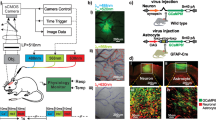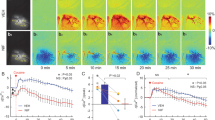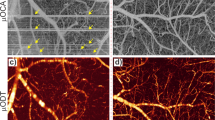Abstract
Cocaine-induced stroke is among the most serious medical complications associated with its abuse. However, the extent to which acute cocaine may induce silent microischemia predisposing the cerebral tissue to neurotoxicity has not been investigated; in part, because of limitations of current neuroimaging tools, that is, lack of high spatiotemporal resolution and sensitivity to simultaneously measure cerebral blood flow (CBF) in vessels of different calibers (including capillaries) quantitatively and over a large field of view. Here we combine ultrahigh-resolution optical coherence tomography to enable tracker-free three-dimensional (3D) microvascular angiography and a new phase-intensity-mapping algorithm to enhance the sensitivity of 3D optical Doppler tomography for simultaneous capillary CBF quantization. We apply the technique to study the responses of cerebral microvascular networks to single and repeated cocaine administration in the mouse somatosensory cortex. We show that within 2–3 min after cocaine administration CBF markedly decreased (for example, ∼70%), but the magnitude and recovery differed for the various types of vessels; arterioles had the fastest recovery (∼5 min), capillaries varied drastically (from 4–20 min) and venules showed relatively slower recovery (∼12 min). More importantly, we showed that cocaine interrupted CBF in some arteriolar branches for over 45 min and this effect was exacerbated with repeated cocaine administration. These results provide evidence that cocaine doses within the range administered by drug abusers induces cerebral microischemia and that these effects are exacerbated with repeated use. Thus, cocaine-induced microischemia is likely to be a contributor to its neurotoxic effects.
This is a preview of subscription content, access via your institution
Access options
Subscribe to this journal
Receive 12 print issues and online access
$259.00 per year
only $21.58 per issue
Buy this article
- Purchase on Springer Link
- Instant access to full article PDF
Prices may be subject to local taxes which are calculated during checkout





Similar content being viewed by others
References
Volkow ND, Mullani N, Gould KL, Adler S, Krajewski K . Cerebral blood flow in chronic cocaine users: a study with positron emission tomography. Br J Psychiatry 1988; 152: 641.
Howington JU, Kutz SC, Wilding GE, Awasthi D . Cocaine use as a predictor of outcome in aneurysmal subarachnoid hemorrhage. J Neurosurg 2003; 99: 271–275.
Pozzi M, Roccatagliata D, Sterzi R . Drug abuse and intracranial hemorrhage. Neurol Sci 2008; 29: 269–270.
Bartzokis G, Beckson M, Hance DB, Lu PH, Foster JA, Mintz J et al. Magnetic resonance imaging evidence of ‘silent’ cerebrovascular toxicity in cocaine dependence. Biol Psychiatry 1999; 45: 1203–1211.
Toossi S, Hess CP, Hills NK, Josephson SA . Neurovascular complications of cocaine use at a tertiary stroke center. J Stroke Cerebrovasc Dis 2010; 19: 273–278.
Nanda A, Vannemreddy P, Willis B, Kelley R . Stroke in the young: relationship of active cocaine use with stroke mechanism and outcome. Brain Edema XIII 2006; 96: 91–96.
Westover AN, McBride S, Haley RW . Stroke in young adults who abuse amphetamines or cocaine: a population-based study of hospitalized patients. Arch Gen Psychiatry 2007; 64: 495–502.
Weissleder R, Pittet MJ . Imaging in the era of molecular oncology. Nature 2008; 452: 580–589.
Drew PJ, Shih AY, Driscoll JD, Knutsen PM, Blinder P, Davalos D et al. Chronic optical access through a polished and reinforced thinned skull. Nat Methods 2010; 7: 981–984.
Brown EB, Campbell RB, Tsuzuki Y, Xu L, Carmeliet P, Fukumura D et al. In vivo measurement of gene expression, angiogenesis and physiological function in tumors using multiphoton laser scanning microscopy. Nat Med 2001; 7: 864–868.
Chaigneau E, Oheim M, Audinat E, Charpak S . Two-photon imaging of capillary blood flow in olfactory bulb glomeruli. Proc Natl Acad Sci USA 2003; 100: 13081.
Vakoc BJ, Lanning RM, Tyrrell JA, Padera TP, Bartlett LA, Stylianopoulos T et al. Three-dimensional microscopy of the tumor microenvironment in vivo using optical frequency domain imaging. Nat Med 2009; 15: 1219–1223.
Srinivasan VJ, Jiang JY, Yaseen MA, Radhakrishnan H, Wu W, Barry S et al. Rapid volumetric angiography of cortical microvasculature with optical coherence tomography. Opt Lett 2010; 35: 43–45.
Wang RK, Jacques SL, Ma Z, Hurst S, Hanson SR, Gruber A . Three dimensional optical angiography. Opt Express 2007; 15: 4083–4097.
An L, Qin J, Wang RK . Ultrahigh sensitive optical microangiography for in vivo imaging of microcirculations within human skin tissue beds. Opt Express 2010; 18: 8220–8228.
Yuan Z, Chen B, Ren H, Pan Y . On the possibility of time-lapse ultrahigh-resolution optical coherence tomography for bladder cancer grading. J Biomed Opt 2009; 14: 050502.
Fujimoto JG . Optical coherence tomography for ultrahigh resolution in vivo imaging. Nat Biotechnol 2003; 21: 1361–1367.
Yuan Z, Luo Z, Volkow N, Pan Y, Du C . Imaging separation of neuronal from vascular effects of cocaine on rat cortical brain in vivo. NeuroImage 2010; 54: 1130–1139.
Mehta SV, Gluncic V, Iqbal SM, Frank J, Ansari SA . Role of perfusion imaging in differentiating multifocal vasospasm-related ischemia versus thromboembolic stroke in a setting of cocaine abuse. J Stroke Cerebrovasc Dis 2011; doi:10.1016/j.jstrokecerebrovasdis.2011.04.014.
Hatsukami DK, Thompson TN, Pentel PR, Flygare BK, Carroll ME . Self-administration of smoked cocaine. Exp Clin Psychopharmacol 1994; 2: 115.
Luo Z, Wang Z, Yuan Z, Du C, Pan Y . Optical coherence Doppler tomography quantifies laser speckle contrast imaging for blood flow imaging in the rat cerebral cortex. Opt Lett 2008; 33: 1156–1158.
Luo Z, Yuan Z, Tully M, Pan Y, Du C . Quantification of cocaine-induced cortical blood flow changes using laser speckle contrast imaging and Doppler optical coherence tomography. Appl opt 2009; 48: D247–D255.
Krimer LS, Muly EC, Williams GV, Goldman-Rakic PS . Dopaminergic regulation of cerebral cortical microcirculation. Nat Neurosci 1998; 1: 286–289.
He GQ, Zhang A, Altura BT, Altura BM . Cocaine-induced cerebrovasospasm and its possible mechanism of action. J Pharmacol Exp Ther 1994; 268: 1532.
Ohtsuki S, Yamaguchi H, Kang YS, Hori S, Terasaki T . Reduction of L-type amino acid transporter 1 mRNA expression in brain capillaries in a mouse model of Parkinson's disease. Biol Pharm Bull 2010; 33: 1250–1252.
Albuquerque MLC, Dean Kurth C . Cocaine constricts immature cerebral arterioles by a local anesthetic mechanism. Eur J Pharm 1993; 249: 215–220.
Du C, Tully M, Volkow ND, Schiffer WK, Yu M, Luo Z et al. Differential effects of anesthetics on cocaine's pharmacokinetic and pharmacodynamic effects in brain. Eur J Neurosci 2009; 30: 1565–1575.
Mandeville JB, Choi JK, Jarraya B, Rosen BR, Jenkins BG, Vanduffel W . fMRI of Cocaine self-administration in macaques reveals functional inhibition of basal ganglia. Neuropsychopharmacology 2011; 36: 1187–1198.
Hollander JE . Cocaine intoxication and hypertension. Ann Emerg Med 2008; 51: 18.
Acknowledgements
This work was supported in part by the National Institutes of Health Grants K25-DA021200 (CD), 2R01-DK059265 (YP), 1RC1DA028534 (CD and YP), 1R21-DA032228 (CD and YP) and NIAAA Intramural Research Program (NDV).
Author information
Authors and Affiliations
Corresponding authors
Ethics declarations
Competing interests
The authors declare no conflict of interest.
Additional information
Supplementary Information accompanies the paper on the Molecular Psychiatry website
Supplementary information
Rights and permissions
About this article
Cite this article
Ren, H., Du, C., Yuan, Z. et al. Cocaine-induced cortical microischemia in the rodent brain: clinical implications. Mol Psychiatry 17, 1017–1025 (2012). https://doi.org/10.1038/mp.2011.160
Received:
Revised:
Accepted:
Published:
Issue Date:
DOI: https://doi.org/10.1038/mp.2011.160
Keywords
This article is cited by
-
Astrocytes modulate cerebral blood flow and neuronal response to cocaine in prefrontal cortex
Molecular Psychiatry (2024)
-
Dynamic 3D imaging of cerebral blood flow in awake mice using self-supervised-learning-enhanced optical coherence Doppler tomography
Communications Biology (2023)
-
Cocaine’s cerebrovascular vasoconstriction is associated with astrocytic Ca2+ increase in mice
Communications Biology (2022)
-
Ca2+ channel blockade reduces cocaine’s vasoconstriction and neurotoxicity in the prefrontal cortex
Translational Psychiatry (2021)
-
The Blood–Brain Barrier: Much More Than a Selective Access to the Brain
Neurotoxicity Research (2021)



